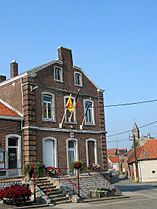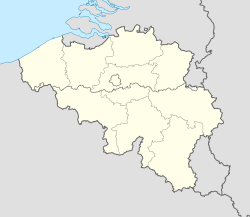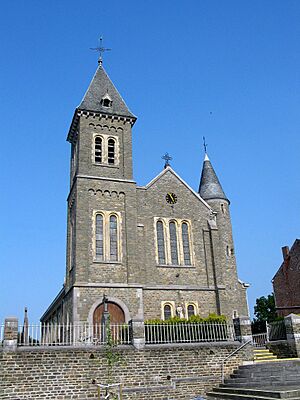Crisnée facts for kids
Quick facts for kids
Crisnée
Crusnêye (Walloon)
|
|||
|---|---|---|---|
 |
|||
|
|||
| Country | Belgium | ||
| Community | French Community | ||
| Region | Wallonia | ||
| Province | Liège | ||
| Arrondissement | Waremme | ||
| Area | |||
| • Total | 16.83 km2 (6.50 sq mi) | ||
| Population
(2018-01-01)Lua error in Module:Wd at line 1575: attempt to index field 'wikibase' (a nil value).
|
|||
| • Total | Lua error in Module:Wd at line 1,575: attempt to index field 'wikibase' (a nil value). | ||
| Postal codes |
4367
|
||
| Area codes | 04 | ||
| Website | www.crisnee.be | ||
Crisnée (pronounced kris-NAY) is a small town, also called a municipality, in Belgium. It is located in a region called Wallonia, which is in the southern part of Belgium where people mostly speak French. Crisnée is part of the province of Liège.
The municipality covers an area of about 16.83 square kilometers. That's about 6.5 square miles. In 2013, around 3,094 people lived there. This means the population density was about 184 people per square kilometer. Population density tells you how many people live in a certain amount of space.
About Crisnée
Crisnée is a charming place in the Belgian countryside. It is known for its quiet atmosphere and green landscapes. The town is a great example of a typical Belgian municipality.
Where is Crisnée?
Crisnée is located in the province of Liège. This province is in the eastern part of Belgium. It is part of the Wallonia region. Wallonia is one of the three main regions of Belgium.
What are its parts?
The municipality of Crisnée is made up of several smaller areas. These are like different neighborhoods or villages that belong to the same town. The main parts of Crisnée are:
- Crisnée (the central town)
- Fize-le-Marsal
- Kemexhe
- Odeur
- Thys
Each of these smaller areas has its own unique character.
Friends Around the World
Crisnée has a special connection with another town far away. It is "twinned" with the commune of Sansais in western France. Being twinned means that two towns in different countries become partners. They often share culture, ideas, and sometimes even have student exchange programs. It's a way for communities to build friendships across borders.
See also
 In Spanish: Crisnée para niños
In Spanish: Crisnée para niños





